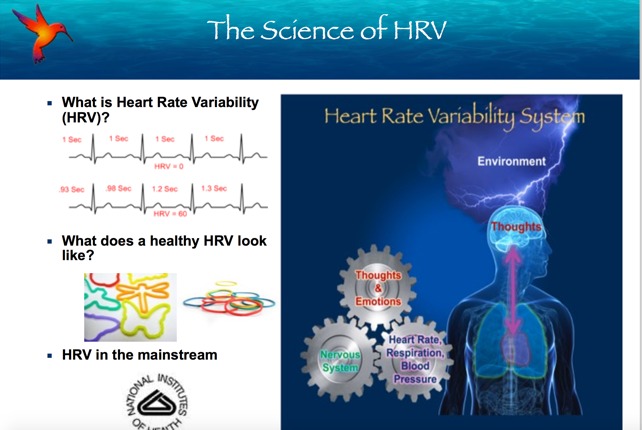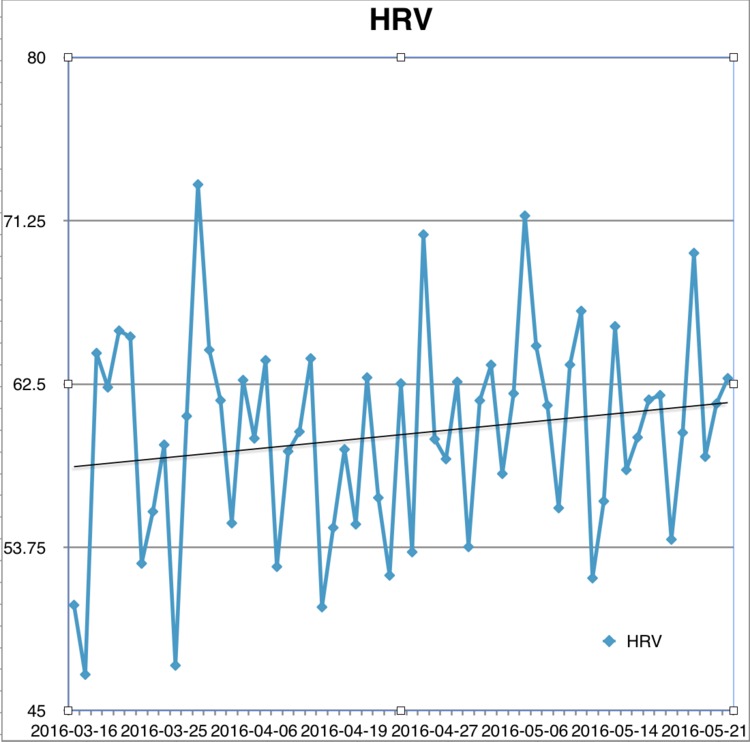Deep Sleep and HRV
Measuring the Positive Impact of Sleep on Your Body
HRV is the single most important measurement of your nervous system that you could ever make.
Keep reading to find out and see helpful graphs,
from experts who have used the SR1 and also tracked the health of their nervous systems.
What is HRV?
HRV is the physiological phenomenon of variation in the time interval between heartbeats. It is measured by the variation in the beat-to-beat interval and a reliable reflection of the many physiological factors modulating the normal rhythm of the heart. In fact, it provides a powerful means of observing the interplay between the sympathetic (fight or flight branch) and parasympathetic (rest and repair branch) nervous systems. It shows that the structure generating the signal is not only simply linear, but also involves nonlinear contributions. Heart rate (HR) is a non-stationary signal; its variation may contain indicators of current disease, or warnings about impending cardiac diseases. The indicators may be present at all times or may occur at random—during certain intervals of the day. It is strenuous and time consuming to study and pinpoint abnormalities in voluminous data collected over several hours. Hence, HR variation analysis (instantaneous HR against time axis) has become a popular noninvasive tool for assessing the activities of the autonomic nervous system.➀

HRV Simplified
Your heart beat varies from beat to beat. This naturally occurring irregularity is your heart rate variability. Counter intuitively the higher your heart rate variability, the healthier you are. People think that if your heart rate is 60 bpm then your heart is beating once per second but this is not the case. In fact if it were, you would be very ill. An example of normal heart beat intervals will be, .93 s, .98s, 1.2s, 1.3s, etc. This variability is due to your heart responding to the signals of your nervous system.
A good analogy is a new rubber band. If you pull the rubber band and let it go, it’s very responsive, it snaps back. Take an old rubber band you can pull and it’s not as responsive and it barely returns to it’s original shape. The more responsive your nervous system, the greater variability between beats, the higher your HRV.
HRV and Medical Science
The National Institutes of Health (NIH) is just one of the many institutions and individuals researching HRV and using HRV in the monitoring and treatment of patients. The Mayo Clinic, Stanford University Hospital and Clinics, and Mount Sinai Medical Center and School of Medicine are among the many prestigious research centers studying HRV and using it in clinical practice… click to keep reading.
What does HRV mean to me?
Over a quarter-century of clinical research has shown that when HRV levels are high, a person experiences low levels of stress and greater resiliency. When HRV levels are low, this is an indication of greater stress and lower resiliency.
Lowered HRV can be due to a number of different factors, including age, gender, disease or stress, among many other things. Stress can be induced by many different influences, from internal worries to stress on the body caused by exertion or surgery. Stress acts directly on the autonomic nervous system, creating imbalance in the tug-of war. When the autonomic nervous system is in balance, HRV tends to be higher, and when it is out of balance, HRV tends to be lower. This makes it a good biomarker for stress. The good news is that individuals can easily train themselves to increase their HRV levels➁. Although HRV is a function of the body’s autonomic nervous system and normally not under conscious control, when HRV is monitored so that people receive biofeedback on the results of what they think or do, they can learn to raise HRV through techniques such as conscious breathing, meditation, or physical relaxation. HRV monitoring is non-invasive and involves using an external heart monitor (a number of which are available to the general public today at reasonable prices). Monitors can be strapped on the chest, clipped onto the earlobe or finger, or even built into “smart” clothing.
HRV can be used as an indicator for many other purposes beyond stress reduction. It can be used in fitness training and recovery, providing feedback on when to lighten up and when to push harder. It can be used to gauge how well you are connecting with others. It can also be used to remotely monitor the health and wellbeing of a family member who may be ill or elderly.➂
Sleep and HRV
Sleep quality has profound impact on your daily performance and well being. During sleep your body and mind recovers from the mental and physical load of our daily life. Routine use of the SR1 sleep device has shown effective in affording the user a deeper, more rejuvenating sleep. Data has shown a significant increase in HRV readings with a variety of clientele over a two month period.
Jo Beth Dow, Cofounder and COO of Sweetwater Health, LLC., put the SR1 sleep device to the test
The above are actual screenshots of HRV data, pulled from a clients portfolio, while routinely using the SR1 sleep device, showing a significant increase in HRV from May 13 – July 20, 2016.
Jo Beth Dow, Cofounder and COO of Sweetwater Health, LLC., put the SR1 sleep device to the test, to see what effect PEMF technology could have on her HRV. Her findings and review of the technology are impressive, and found below.
I am always searching for new techniques and technology that will help improve HRV. Our partner and friend, Ben Greenfield of Ben Greenfield Fitness highly recommended the Delta Sleeper and he was posting his morning HRV after using the device. I was intrigued after viewing Ben’s posts and I had to try it for myself.
I started using the Delta Sleeper SR1, a 1.5 ounce device, to determine what affect PEMF had on my heart rate variability. Being an ultra lark I never had difficulty falling asleep but sometimes I had difficulty staying asleep. I would wake up between 3:30 am and 4:30 am and start working. Fortunately, I was getting 7 to 7 1/2 hours of sleep per night. I never fully understood until now what affect my rather unique sleep schedule had on my husband.
The Delta Sleeper SR1 was easy to use and while I was sleeping I wasn’t even aware that I was wearing it. The Delta Sleeper SR1 is a small device that you place on your brachial plexus using a thin adhesive strip. The first night I did not notice any difference. The second night I was restless but woke up feeling unusually good. The third night I had decided not to wear the SR1 and I had a very restless night. I got up in the middle of the night and placed the SR1 on my forehead (this is not recommended application) but I was too groggy to apply the adhesive and place it on my brachial plexus. I slept in until 7:25 am and felt wonderful!
I have continued to use the SR1 every night. Even on the nights that I am not sleeping longer, I feel especially clear, relaxed and focused in the morning. One night I told my husband I wasn’t going to wear the SR1. I wanted to test the quality of my sleep without the product. My husband responded, “You’re not?” I replied, “What, you want me to wear it?” His response was, “I want you to implant it.”
The SR1 has not only helped me sleep longer but as a secondary effect helped my husband sleep better. Even the nights that I don’t sleep longer than my previous norm I feel like I am getting more quality sleep and sleeping deeper. I have two months of HRV data since using the SR1. My morning HRV has increased 9 points and is moving on an upward trend, reached an all time high HRV on several mornings and my afternoon HRV and LF/HF power levels have increased. The numbers are impressive especially since the HRV value is logarithmic.
— Jo Beth Dow, co-founder and CTO of SweetWater Health

The above graph shows a substantial increase in HRV, from Jo Beth’s two month test of the SR1 sleep device.
Ben Greenfield
With bengreenfieldfitness.com , using his own NatureBeat HRV app, put the SR1 sleep device to the test. His findings and sentiment about the SR1 sleep device are game changing:
My sleep is so darn important that when it comes to sleep, I test everything, and I mean *everything* – from supplements to gear to bedding and beyond. When it comes to the impact of my deep sleep and my nervous system, the SR1, is, hands down, one of THE most effective tools I have ever used for myself and for my clients to achieve deep, high quality sleep.
— Ben Greenfield, bengreenfieldfitness.com
Analyzing HRV and Stress along with additional data, provides a deep dive into health and provides insight into what activities you engage in that effect the health metrics you care about. This is important because the next big trend in bio-hacking is understanding the relationships between different metrics like your quality of sleep, weight, your blood pressure, your blood glucose, the number of steps you take and your actual internal health and nervous system.
The above screenshots are some of Ben Greenfields actual HRV findings, and media posts during his trial of the SR1 sleep device.
Months later, and with hundreds of his clients successfully using the SR1 sleep device, Ben continues to quantify his sleep via HRV.
Get Started with HRV
So are you interested in testing for yourself how your nervous system responds to natural PEMF frequencies during the night, and the sleep patterns the SR1 sleep device induces?
Here’s how to get started:
Step 1: Click here to view and purchase the various approved heart rate monitors.
Step 2: Click here to download the bengreenfieldfitness.com NatureBeat HRV tracker app.
Step 3: Click here to download the SweetWater Health DailyBeat HRV app.
Step 4: Click here to purchase the SR1 sleep device.
If you have questions, comments or feedback, contact Michael directly at customerservice@somniresonance.com


